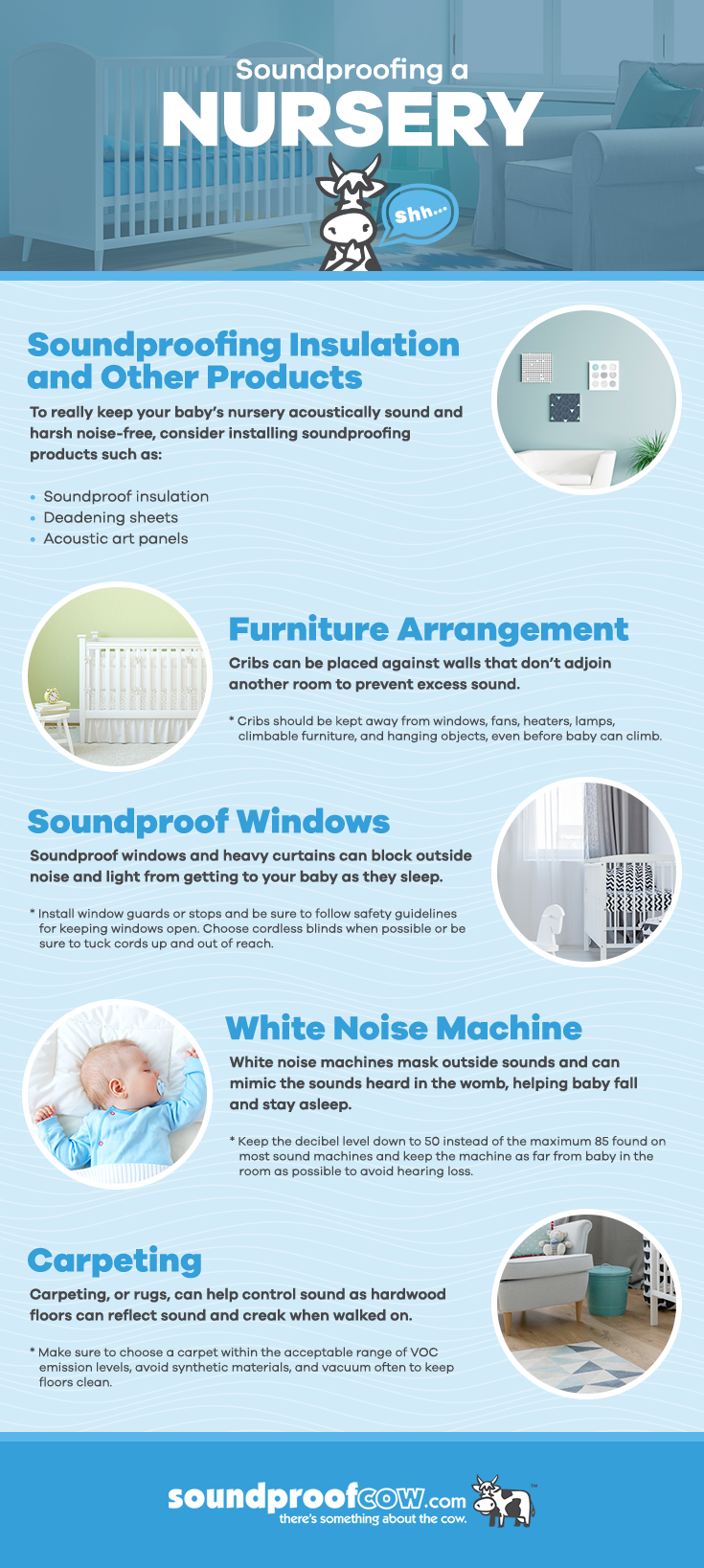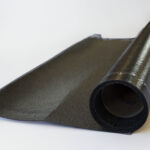
If you’ve got a baby, or you have one on the way, you may have already considered nursery soundproofing. While there’s no way to stop your baby from crying at times, or sleeping and waking at a schedule that’s not convenient to you, nursery sound control can help your baby stay asleep. It may even help your baby stay calm throughout the day, thanks to fewer sudden or harsh noises that might tend to disturb them.
If you’re interested in soundproofing a nursery, you may not know where to begin. The truth is, soundproofing your nursery doesn’t need to be a major home renovation project. In fact, taking steps to protect your child’s nursery from unwanted and unexpected sounds can be much easier than you might think.
How Babies Perceive Sound
Your baby starts hearing before he is even born, so there will be sounds that are familiar right away. Like the rest of us, there are some sounds babies prefer more than others. These include:
- White noise: They may also respond to brown noise and other blanketing sounds, like the air conditioner, vacuum cleaner or static. These are soothing to babies because they resemble the whooshing sounds in the womb.
- Higher-pitched talking: There’s a reason everyone uses baby talk with babies. They respond to it! Babies tend to be more engaged with higher more melodic frequencies than lower ones. This is because a newborn’s hearing is still a bit immature, and the middle ear is still full of fluid.
- Music: Just like us, babies love the sound of music! The trick is finding the right music. If you played a lot of music when your child was in the womb, that might be your first go-to when trying to find music your baby will respond to.
When it comes to soundproofing solutions in your nursery, what’s important is not so much blocking out all sound, but improving the quality of the sound in the room. You’ll want to deaden and soften harsher noises so that your baby can focus on the right sounds.
Complete silence is not necessarily what your baby needs to sleep and be comfortable. He is used to hearing sounds in the womb. However, those sounds are naturally muffled or deadened, so what you are looking for in your nursery is a way to use soundproofing to duplicate that effect.
Can Soundproofing Help a Baby Sleep Through the Night?
You may be wondering if soundproofing your nursery will ensure your baby will sleep through the night. The answer is that it will probably help, especially if your baby is waking up more than normal, but how much uninterrupted sleep your baby will get depends on other factors.
Babies’ sleep cycles are not the same as adults’. An adult usually moves quickly through periods of light sleep into deeper sleep, where they remain for a good while, occasionally briefly moving into lighter sleep and then back into deeper sleep again. Typically, there are only a few periods of light sleep per night — absent other factors that may affect sleep.
Your baby, however, cycles much more frequently, with many cycles of deeper and lighter sleep per night. While in a deep cycle, your child can easily sleep through ambient noise without a problem just like you. However, during those many light cycles, they are much more susceptible to waking up when louder or harsh sounds are introduced.
Good soundproofing, as well as white noise, can help guide your baby through those light sleep cycles, so he remains asleep through most of them, although it is unlikely he will remain asleep through all of them.
No matter how light or deep a sleeper your baby tends to be, good soundproofing in the nursery can allow more restful sleep, both for you and your baby. It can provide more comfort and less stress.
How to Make Your Baby’s Room Soundproof — Areas to Focus On
To make a soundproof baby room, you need to follow some best practices. Sound can come from unexpected places, contributing to louder noises in your baby’s room. To fully utilize the tips found in the next section, you need to know more about where sound can come from and disturb your child’s sleep. And of course, you should also know where sound can travel from your baby’s room and disturb your neighbors.
Here are the areas you should focus on when soundproofing a nursery:
- The door: Some doors are flimsier than others. Hollow doors will allow more sound to travel in both directions, while solid doors can act as good sound deadeners. Also look for gaps around the nursery door, as these small cracks can allow a lot of sounds through. A door that fits snugly in the door frame will help block out sounds.
- The floor: If you have neighbors below your baby’s room, the floor can be a major culprit for disrupting sounds. The sounds from the activities below can travel up through the floor and surprise your child awake from their nap.
- The ceiling: As the floors can contribute to sound, so can the ceiling. This is mostly true if you have neighbors living above you. Footsteps can easily travel through your neighbor’s floor into your ceiling, especially if their floors consist of hard material without any rugs or carpeting. Low frequencies from speakers and televisions can also contribute to noise and vibrations through your ceiling.
- The walls: Walls vary in their ability to absorb sounds. If you share any walls with neighbors, there’s a good chance some noise from their living space may bleed into your baby’s nursery. You should also be wary of sounds from your own home getting into the baby’s room, so try to choose a room for your baby that is adjacent to the quieter rooms in the building.
- The windows: Windows are also notorious for letting unwanted sound into a room. Single-pane windows are the worst for soundproofing, while double-pane windows offer a bit more soundproofing. But what makes the biggest difference is what’s on the outside of a window. A busy main street could be noisy, but a peaceful backyard will be much quieter and more predictable.
5 Tips for Soundproofing a Nursery
If you’re ready to take the first steps to a calmer, quieter household, here are a few nursery sound control tips to get you started.
1. Carpeting
Carpeting can go a long way toward good sound control for a nursery. Even just throwing down a few rugs can help, as hardwood floors can reflect sound and can lead to creaking and clacking when someone walks across it.
2. Arranging Furniture
Putting your baby’s crib up against a wall that doesn’t adjoin another room can help prevent them from experiencing excess sound. There are also decorating sites online that can offer tips on how to best arrange your nursery furniture for optimal noise control.
3. Soundproof Windows
If your nursery has windows, replacing them with soundproof windows can help prevent a lot of the noise pollution from out on the street from getting into your home and disturbing your baby. Whether you opt to soundproof your windows or not, you may want to invest in some good, heavy curtains which can block both noise and light from getting to your baby when he or she is trying to sleep.
4. White Noise Machine
The benefits of white noise and white noise machines can be truly remarkable. Studies have shown that white noise can have marvelous effects on babies, as it does on adults. White noise machines mask other sounds that may disturb or startle your baby and can even mimic sounds the baby heard in the womb, leading to a calmer baby who gets to sleep easier and stays asleep longer.
5. Soundproofing Insulation and Other Products
To really keep your baby’s nursery acoustically sound and harsh noise-free, consider installing soundproofing products from Soundproof Cow. These products are the keys to creating a soundproof baby room and include the following items:
- Soundproof Underlayment: For noisy floors, soundproof underlayment you can put under flooring is one of the most effective options. These products will absorb sounds and vibrations, and they will also ensure whoever is below your floors has a more peaceful experience, too.
- Deadening sheets: A lot of noise can travel through walls, but Soundproof Cow’s sound deadening sheets can help. These products are excellent for absorbing vibrations that could contribute to unwanted noises in your baby’s nursery.
- Acoustic art panels: Acoustic art panels serve the double purpose of absorbing sound and providing a visual display that can amuse your child and add to the appeal of the nursery’s décor. These panels will also increase the sound quality in the room, reducing the amount of echo and reverberation that bounces between the nursery walls. These panels can make your baby’s cries a little less harsh on the ears.
- Soundproof barriers: For highly effective soundproofing, you can hang soundproofing barriers from Soundproof Cow on the walls or even in the middle of a room for a more isolated experience.
Get Started With Your New Soundproof Nursery Now
The benefits of a soundproof nursery are difficult to calculate. If you’ve been suffering from a lack of sleep or you’re concerned about your baby’s health due to excessive crying, sound control for your nursery can make a world of difference. You may quickly find that you, your spouse and your child are happier and sleeping better.
For all the soundproofing materials you need to make a great DIY soundproof nursery, head on over to Soundproof Cow right now and shop our residential soundproofing products. Contact us today for more information!





![Get Started With Your New Soundproof Nursery]](https://www.soundproofcow.com/wp-content/uploads/2017/06/03-Soundproof-Any-Home-or-Apartment-in-Any-Neighborhood-With-Sound.png)







